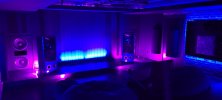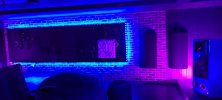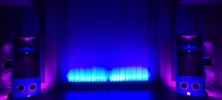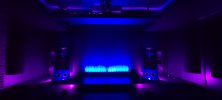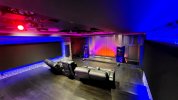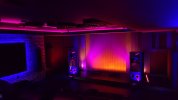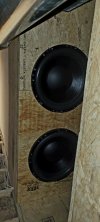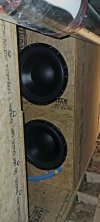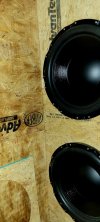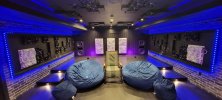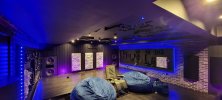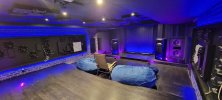12/16/2022 Edit: Pics added
10/18/2023 Edit: Pics updated
Hello ASR Friends!
This thread is to consolidate information and share the outcome of my room build for those who’ve expressed interest along the way. There are headings so you can read only what you're interested in.
Notes
Project Priorities
In order of importance:
Due to the bedroom above and a desire for continued marital harmony, sound isolation was also a key design consideration; Nyal’s isolation recommendations have exceeded my expectations in real-world performance by a wide margin. I can listen to bass heavy music at any level I care to listen at for an entire song, and my wife’s sleep is not disturbed. Short but loud demos might be disturbing upstairs, but thus far she has never heard anything.
My priorities for audio system performance were:
Gear Selection
All A/V equipment is located outside of the theater in a (yet to be installed) AV rack, so fan noise is a non-issue.
Room Construction
All walls and ceilings are floating via metal spring or rubber isolation mounts (per specifications provided by Nyal; See Acoustic Frontiers guide to bass e-book for more info) to reduce bass resonances and provide acoustic isolation. Concrete walls are a single layer of 5/8" Soundbreak Board, and other walls and ceilings are multiple layers with damping compound. Soundbreak board was a miscommunication with the contractor, but I appreciate the extra isolation.
The rear ~1/2 of the room floor is a 12" riser that functions as a bass trap, along with the entire front and rear walls serving as bass traps/mid-high frequency reflectors, with engineering and design provided by Nyal.
The final finished room dimensions are ~28'x19'x8.5', with a combined ~4' taken by the front and rear false walls, giving an apparent size of ~19'Wx24'D. The 4'Dx 13'Wx 8.5'H irregularity in the rear of the room became a very large subwoofer enclosure with 2x6 construction and multiple layers of 3/4" plywood and a vibration cancelling manifold to hold the four Stereo Integrity IB-24s for infrasonics.
The four JBL 5628 subs are built-in to each corner of the room for even seat-to-seat bass response. I plan to perform MSO in the coming weeks (implemented with the built-in Crown amp DSP). Once the covers are built, the only visible speakers will be the M2s up front.
FYI, Nyal asked if I was willing to dig out the front of the room floor instead of building a rear riser, which would also increase the ceiling height over the listening position... that was a bridge too far, and I believe the only significant suggestion he made that I declined to implement.
HVAC
HVAC has variable static pressure to avoid over/under conditioning the space based on occupancy; max flow was the design criteria for HVAC noise thresholds, and then the CFM can be decreased since I seldom have 8+ people in the room. HVAC inlet and outlet have muffler boxes, and the ducts/grills are large to avoid turbulent flow noise. HVAC is barely audible when running with an otherwise silent room; any sound (conversation or music) immediately masks the HVAC and you need a quiet room to tell if it's running or not... Not a Skywalker Ranch scoring stage, but wonderful for recreational listening.
Acoustics
Acoustic treatment is a mix of diffusion and absorbsion. Sidewall early reflections are diffused. RT60 (per Trinnov) of the untreated room (but with the rear riser and front and rear false wall bass traps in place) was 0.74 seconds, with treatments installed 0.51 seconds, and with two giant bean bags chairs 0.39 seconds. The rooms sounds great either way, but I prefer the sound without the bean bag chairs. Leather chairs in the future may bring the RT60 back up a bit.
Appearance
I wanted to capture the vibe of a live performance space or a small music hall to add to the atmosphere of the musical experience. I would say it was a success, because nearly every person who has entered the room has said or asked some variation of 'would you ever have a real band play in here?', 'do you have band? do you play in here?', or 'it looks like a band should be on the stage'. I'll call it a success.
The vibe was created with white oak hardwood floors with black stain, matte black ceiling, black brick veneer on the sidewalls, exposed vertical 1x6 boards (in cabinet finish black) forming the front and rear false walls and then extending them onto the sidewall of the stage; all exposed fabric is also black. The sidewall acoustic panels are framed in and will eventually be covered in fabric. The brick is lit in high relief by RGB tape lighting. The ceiling perimeter also has RGB tape lighting and I've added front and rear RGB wall wash lighting along with wash lighting for the L/R speakers. Without the RGB lighting the black is oppressive, with the lighting it's a total escape.
Oh, and the M2s have a custom candy apple electric blue automotive finish (they were damaged in shipping and this was the solution).
Pictures

(Top photo by Jay Greene Photography)

(This photo most representative of what the eye sees)
Other photos attached show the acoustic treatments and early test lighting.
Miscellaneous
In-Room Measurements
Coming soon... [what measurements would anyone like to see?]
Note that I prefer to use Omnimic due to ease of use. That said, I could possibly be persuaded to reengage with REW since I'll need it for Multi-Sub Optimization
Bass is flat to ~6.5hz. I don't know how much output is available, but there was no change in frequency response even at 117db with pink noise... I didn't care to push it any louder.
Subjective Results
I'm happy. Very happy. The low noise floor of the room has allowed the reverb and ambiance of tracks to really shine. Even with only a rough calibration (no MSO), the bass is tight, deep, and articulate... it's almost like it isn't there, even though it's there in abundance! Stereo sounds are wide and enveloping on many tracks, coming out to nearly the 180 degree position. Some tracks have reverb that comes from the sides, up high, and even behind the listening position. Stereo placement of sounds is precise all across the front sound-stage including well beyond the speakers, and yet the sound can be enveloping at the same time. There are even height and depth sensations; family and friends generally report the same shared spatial perceptions when asked--with no leading suggestion--what they're hearing and where.
One guest said it best, 'the walls and ceiling of the room don't exist, the speakers don't exist, sound just originates from nowhere and extends without limits until fading out, except for the singer, or certain sounds, or key instruments, which all have very precise locations'.
I do NOT like Harman's new curve supplied with the SDP-75; I find it dull, lacking in spaciousness, and lacking in vocal clarity. I don't know what the target room acoustic conditions are for their new curve, but my room isn't it.
The transition to the infra-sub is perceptually seamless, and most of the time it does very little... but the tracks that use the infra-sub just wouldn't be the same without it.
I wouldn't change the overall set of trade-offs I have now with the more lively room for the overdamped rooms I'm used to, however, it is a trade-off. The over damped rooms have an extra level of clarity that would be appealing for content creation, the sound seems bigger and closer and more imposing (in a good way!) due to the lack of early reflections, and good recordings with intentional spatial cues can be a tad more impressive with more depth coming out into the room or behind the speakers. However... The exceptional studio recordings are very nearly as impressive in the more lively space, yet many other recordings become much more impressive. And poor recordings are more listenable in the lively space. The damped room exposed every facet of each recording's acoustic space, and each track has it's own sonic fingerprint... the more lively room adds just a touch of 'sameness' to all tracks. But overall, I much prefer the more lively listening space for overall enjoyment. Much to my personal surprise, I'm finding I agree with the conclusions of the research shared by Floyd Toole when it comes to the impact of early reflections.
I'm also finding that some of the M2s positive uniqueness is reduced in the more lively space... I certainly don't like them any less, but I also don't find them as distinguished as before; how much of a role did room liveliness (or lack thereof) play in my speaker selection process? I'll probably never know (and don't really care), but I do wonder.
I'll share other random subjective observations in the reserved second post over time.
Thanks for reading... happy to answer questions if there are any!
10/18/2023 Edit: Pics updated
Hello ASR Friends!
This thread is to consolidate information and share the outcome of my room build for those who’ve expressed interest along the way. There are headings so you can read only what you're interested in.
Notes
- I hired Nyal Mellor, owner/founder of Acoustic Frontiers for the layout and engineering aspects, including room layout, sound isolation, room acoustics, treatment plan, and site-built treatment designs. Out of professional courtesy and contractual agreement, I will not be sharing key details of his solutions. Suffice it to say, despite reading and studying sound reproduction and room acoustics as a hobby for years, this project is superior to anything I would have designed myself thanks to Nyal’s consultative approach and expertise; I recommend his services to anyone embarking on a best effort project
- This is a work in progress. The seating, lighting and wiring is temporary; wires will be hidden, fabric wrinkles fixed, lighting optimized, subwoofers covered, etc., etc.
- The camera does not capture the lighting (at all). In person it’s welcoming, sets the mood for all types of music, and aids the immersion… in photos it just looks… bad. Please be kind
Project Priorities
In order of importance:
- Music performance using 2-channel w/subs (If needed, I would compromise anything else before sacrificing 2-channel performance)
- Video performance (Projector/retractable screen installation will be a future phase)
- Surround sound performance (surround speaker installation will be a future phase)
- Appearance (Room performance was to be maximized, and then I would figure out the aesthetics)
Due to the bedroom above and a desire for continued marital harmony, sound isolation was also a key design consideration; Nyal’s isolation recommendations have exceeded my expectations in real-world performance by a wide margin. I can listen to bass heavy music at any level I care to listen at for an entire song, and my wife’s sleep is not disturbed. Short but loud demos might be disturbing upstairs, but thus far she has never heard anything.
My priorities for audio system performance were:
- Neutrality/accuracy
- A lively dynamic presentation with practically unlimited output
- Bass accuracy/output/extension
- Precise stereo imaging and envelopment
- And ultimately, No Mo’ FOMO!!!
Gear Selection
- JBL M2s (Dual I-tech 5000HDs)
- Four JBL 5628 subwoofers for the audible spectrum (I-tech 3500x4HD ~2500 watts/cab, 4000 watts peak)
- Four Stereo Integrity IB-24s in an infinite baffle arrangement for infra-sonics (I-tech 5000HD producing ~1250 watts/driver)
- JBL SDP-75 for processing
- BluOS for streaming and a CD player (both connect to SDP-75 using digital outputs)
All A/V equipment is located outside of the theater in a (yet to be installed) AV rack, so fan noise is a non-issue.
Room Construction
All walls and ceilings are floating via metal spring or rubber isolation mounts (per specifications provided by Nyal; See Acoustic Frontiers guide to bass e-book for more info) to reduce bass resonances and provide acoustic isolation. Concrete walls are a single layer of 5/8" Soundbreak Board, and other walls and ceilings are multiple layers with damping compound. Soundbreak board was a miscommunication with the contractor, but I appreciate the extra isolation.
The rear ~1/2 of the room floor is a 12" riser that functions as a bass trap, along with the entire front and rear walls serving as bass traps/mid-high frequency reflectors, with engineering and design provided by Nyal.
The final finished room dimensions are ~28'x19'x8.5', with a combined ~4' taken by the front and rear false walls, giving an apparent size of ~19'Wx24'D. The 4'Dx 13'Wx 8.5'H irregularity in the rear of the room became a very large subwoofer enclosure with 2x6 construction and multiple layers of 3/4" plywood and a vibration cancelling manifold to hold the four Stereo Integrity IB-24s for infrasonics.
The four JBL 5628 subs are built-in to each corner of the room for even seat-to-seat bass response. I plan to perform MSO in the coming weeks (implemented with the built-in Crown amp DSP). Once the covers are built, the only visible speakers will be the M2s up front.
FYI, Nyal asked if I was willing to dig out the front of the room floor instead of building a rear riser, which would also increase the ceiling height over the listening position... that was a bridge too far, and I believe the only significant suggestion he made that I declined to implement.
HVAC
HVAC has variable static pressure to avoid over/under conditioning the space based on occupancy; max flow was the design criteria for HVAC noise thresholds, and then the CFM can be decreased since I seldom have 8+ people in the room. HVAC inlet and outlet have muffler boxes, and the ducts/grills are large to avoid turbulent flow noise. HVAC is barely audible when running with an otherwise silent room; any sound (conversation or music) immediately masks the HVAC and you need a quiet room to tell if it's running or not... Not a Skywalker Ranch scoring stage, but wonderful for recreational listening.
Acoustics
Acoustic treatment is a mix of diffusion and absorbsion. Sidewall early reflections are diffused. RT60 (per Trinnov) of the untreated room (but with the rear riser and front and rear false wall bass traps in place) was 0.74 seconds, with treatments installed 0.51 seconds, and with two giant bean bags chairs 0.39 seconds. The rooms sounds great either way, but I prefer the sound without the bean bag chairs. Leather chairs in the future may bring the RT60 back up a bit.
Appearance
I wanted to capture the vibe of a live performance space or a small music hall to add to the atmosphere of the musical experience. I would say it was a success, because nearly every person who has entered the room has said or asked some variation of 'would you ever have a real band play in here?', 'do you have band? do you play in here?', or 'it looks like a band should be on the stage'. I'll call it a success.
The vibe was created with white oak hardwood floors with black stain, matte black ceiling, black brick veneer on the sidewalls, exposed vertical 1x6 boards (in cabinet finish black) forming the front and rear false walls and then extending them onto the sidewall of the stage; all exposed fabric is also black. The sidewall acoustic panels are framed in and will eventually be covered in fabric. The brick is lit in high relief by RGB tape lighting. The ceiling perimeter also has RGB tape lighting and I've added front and rear RGB wall wash lighting along with wash lighting for the L/R speakers. Without the RGB lighting the black is oppressive, with the lighting it's a total escape.
Oh, and the M2s have a custom candy apple electric blue automotive finish (they were damaged in shipping and this was the solution).
Pictures
(Top photo by Jay Greene Photography)
(This photo most representative of what the eye sees)
Other photos attached show the acoustic treatments and early test lighting.
Miscellaneous
- Front LCR locations each have two extra runs of 12g speaker wire, RCA cable, and XLR cable to allow easy in-room testing or demoing of other speakers. Is double-blind, level matched, ABX speaker testing in my future, just for fun? Maaaaaaybeeee...
- In the future, the L/R speakers will be on rails to slide between the 2-channel and theater positions
- A pass-through port is installed from the A/V Rack to front-side wall to allow pass through of calibration microphone wires (Omnimic and Trinnov); capped off when not in use. Allows room measurements and noise floor measurements without the door open or laptop noise in the room
- In-ceiling speaker boxes and surround sound speaker wiring is pre-installed/pre-run, projector hushbox and ventilation is pre-installed, HDMI and fiberoptic cable runs pre-installed to hushbox and front-of room for future expansion. Conduit access is pre-installed to hushbox, rear wall, front wall, and side soffit for future expansion. Cat6 runs all over the room for future expansion. Retractable screen wiring pre-installed. Low voltage wiring for final RGB lighting is pre-installed
In-Room Measurements
Coming soon... [what measurements would anyone like to see?]
Note that I prefer to use Omnimic due to ease of use. That said, I could possibly be persuaded to reengage with REW since I'll need it for Multi-Sub Optimization
Bass is flat to ~6.5hz. I don't know how much output is available, but there was no change in frequency response even at 117db with pink noise... I didn't care to push it any louder.
Subjective Results
I'm happy. Very happy. The low noise floor of the room has allowed the reverb and ambiance of tracks to really shine. Even with only a rough calibration (no MSO), the bass is tight, deep, and articulate... it's almost like it isn't there, even though it's there in abundance! Stereo sounds are wide and enveloping on many tracks, coming out to nearly the 180 degree position. Some tracks have reverb that comes from the sides, up high, and even behind the listening position. Stereo placement of sounds is precise all across the front sound-stage including well beyond the speakers, and yet the sound can be enveloping at the same time. There are even height and depth sensations; family and friends generally report the same shared spatial perceptions when asked--with no leading suggestion--what they're hearing and where.
One guest said it best, 'the walls and ceiling of the room don't exist, the speakers don't exist, sound just originates from nowhere and extends without limits until fading out, except for the singer, or certain sounds, or key instruments, which all have very precise locations'.
I do NOT like Harman's new curve supplied with the SDP-75; I find it dull, lacking in spaciousness, and lacking in vocal clarity. I don't know what the target room acoustic conditions are for their new curve, but my room isn't it.
The transition to the infra-sub is perceptually seamless, and most of the time it does very little... but the tracks that use the infra-sub just wouldn't be the same without it.
I wouldn't change the overall set of trade-offs I have now with the more lively room for the overdamped rooms I'm used to, however, it is a trade-off. The over damped rooms have an extra level of clarity that would be appealing for content creation, the sound seems bigger and closer and more imposing (in a good way!) due to the lack of early reflections, and good recordings with intentional spatial cues can be a tad more impressive with more depth coming out into the room or behind the speakers. However... The exceptional studio recordings are very nearly as impressive in the more lively space, yet many other recordings become much more impressive. And poor recordings are more listenable in the lively space. The damped room exposed every facet of each recording's acoustic space, and each track has it's own sonic fingerprint... the more lively room adds just a touch of 'sameness' to all tracks. But overall, I much prefer the more lively listening space for overall enjoyment. Much to my personal surprise, I'm finding I agree with the conclusions of the research shared by Floyd Toole when it comes to the impact of early reflections.
I'm also finding that some of the M2s positive uniqueness is reduced in the more lively space... I certainly don't like them any less, but I also don't find them as distinguished as before; how much of a role did room liveliness (or lack thereof) play in my speaker selection process? I'll probably never know (and don't really care), but I do wonder.
I'll share other random subjective observations in the reserved second post over time.
Thanks for reading... happy to answer questions if there are any!
Attachments
Last edited:

